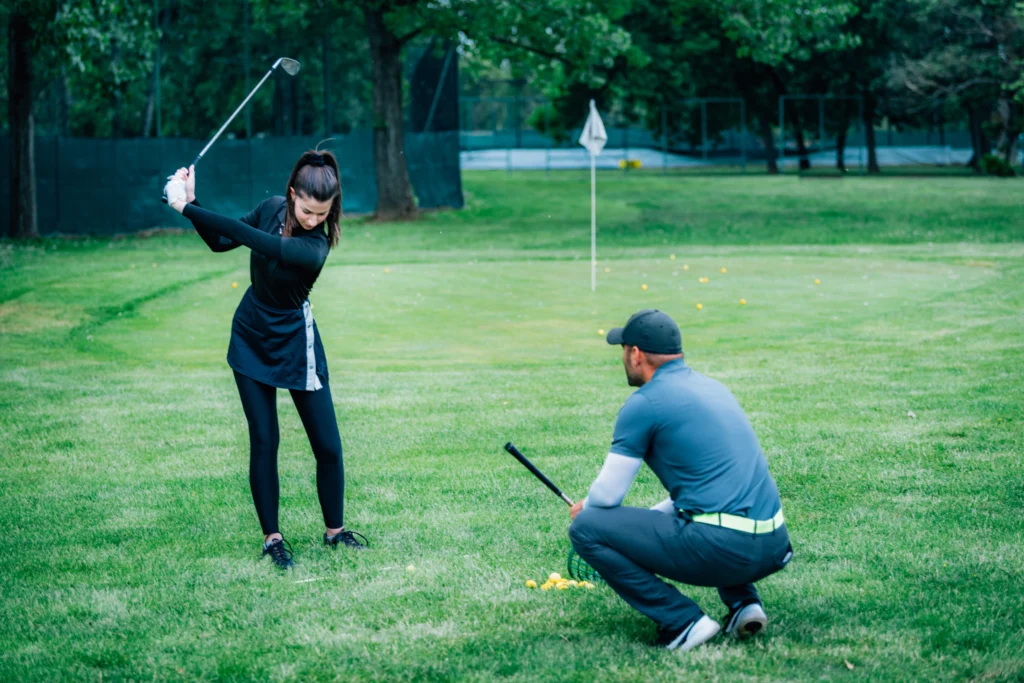
The angle of launch, or shot trajectory, is the path that the ball travels after it has been hit. It is determined by the clubface angle, the swing speed and direction, and the level of spin placed on the ball.
Paying attention to these factors enables golfers to control the distance and direction of their shots.
An illustration of a male golfer is shown with a club on a green golf course and an arc illustrating the flight path of a ball clearly visible.
Golf shot trajectory can best be achieved by mastering how the club and swing adjustments impact the flight path of the ball, e.g. higher for carry, lower for more roll after landing.
The different trajectories depend on the various situations along the course.
With regards to shot trajectory, by taking into account biomechanics and equipment used, a golfer can improve distance and accuracy.
Evaluating the patterns of the shot and the ball’s trajectory aids players in creating better strategies for every shot and playing condition.
Table of Contents
Fundamentals of Golf Shot Trajectory
Golf shot trajectory describes the path the ball takes through the air after being struck. The shape and height of this path depend on several physical factors. Understanding these helps golfers control distance, accuracy, and the ball’s landing behaviour.
Definition of Golf Shot Trajectory
Golf shot trajectory refers to the golf ball’s flight path after it is struck, extending until it touches the ground.
This is determined by the golf ball’s angle of elevation, velocity, and rotation. The launch angle indicates the vertical direction towards which the ball starts ascending after it is struck by the club.
Airborne behaviour of the ball is influenced by spin, backspin prolongs flight, while sidespin shifts the ball sideways. These parameters can be summarized as height, distance, and the degree of curvature.
A balanced amount of control and distance results in a proper trajectory. To achieve player goals, different shots require different trajectories, considering course conditions, player preferences, or objectives.
Factors Affecting Trajectory
Several key factors influence golf shot trajectory:
Club Loft: Higher-lofted clubs create higher trajectories.
Swing Speed: Faster swings generate more ball speed, affecting distance and height.
Impact Location: Hitting the ball on the club’s centre produces more consistent shots.
Spin Rate: Backspin keeps the ball in the air longer, while sidespin causes slices or hooks.
Angle of Attack: Striking the ball with an upward or downward motion changes the launch angle and spin.

Types of Golf Shot Trajectories

Depending on the situation, golfers use different shot trajectories:
High Trajectory: High trajectory shots rise steeply and softly and are used to get over obstacles and stop quickly on the greens. Highest trajectories are produced with wedges and short irons.
Medium Trajectory: A moderate arch that combines control and distance is common for most standard shots, which is why they are the most frequently used shot type. Mid-irons and hybrids are good at creating this path.
Low Trajectory: Shots with a lower flight tend to be more susceptible to wind and roll out farther after they land, but are usually used on wedges.
The drivers tend to have this trajectory when the wind is being controlled, as most people would say they like to use it, or lower lofted irons.
Adjusting to swing types as well as course and weather conditions requires adapting performance which allows strategizing based on course layout using trajectory type.
Techniques to Control Trajectory
Golfers adjust key swing and setup factors to shape the ball’s flight path. They change how high or low the ball launches, how the clubface strikes the ball, and where the ball sits relative to their stance. These elements work together to produce different shot trajectories.
Managing Launch Angles
Launch angle refers to the angle the ball leaves the clubface of the putter head. To execute a low trajectory golf shot, a player needs to minimize this angle. This can be accomplished by increasing the amount of descent in the take back position, which is creating a downward strike rather than a scooping motion.
A more angled backwards stroke aids in sustaining the launch angle closer to the ground. Both elements lie in achieving a lower launch angle where the ball will travel with increased distance, yet reduced height.
Movement of the Clubface and Adjusting the Loft
The trajectory can greatly differ, influenced by the distance of the clubface above and parallel to the attachment of the golf club shaft. While actively performed, adjusting the shaft parallel results in reduced loft. The result is creating less spin and a decreased height of the ball.
Choking down on the grip shaft or changing the wrist orientation suggests minimal movement, encouraging decreased wind exposure throughout the entire shot.
Alongside, this assists in adjusting the trajectory and is demonstrated through a low draw shot while keeping the clubface slightly closed.
Strategic Use of Different Trajectories

When to Use a High Trajectory Shot
A high-flying trajectory golf shot places the golf ball in the air at a steep angle. This is particularly advantageous when attempting to clear trees or bunkers.
Additionally, it enables the golf ball to stop quickly on the green because it descends at a steep angle.
High shots work best during calm winds or gentle breezes coming from behind. They afford greater control over the ball’s placement and reduce roll after landing.
This type of shot is mostly used by players who are more keen on accuracy rather than distance.
Benefits of a Low Trajectory Shot
Low trajectory golf shots feature little to no height and more roll after landing. They’re best for when the wind is strong or blowing towards the player, since this shot is less susceptible to wind.
Players use low shots, especially on open fairways, when they want to maximize distance. The ball will travel faster with increased roll. These shots can be useful in tight or windy playing conditions where a risky high shot would not work.
Course and Weather Factors
The layout of the course and the prevailing weather conditions affect shot selection in golf. Shot selection is affected by low hanging branches or strong winds which require lower shots.
A lower curve shot will not be effective on a firm fairway, as the ball is likely to bounce a lot after landing.
A high shot, on the other hand, is more effective in soft or wet conditions, as it causes the ball to come to a stop more quickly.
Frequently Asked Questions
In what ways does the selection of clubs impact the trajectory of a golf shot?
Different clubs change the angle at which the ball leaves the clubface. Wedges are for higher-pitched, shorter-distance shots, while drivers are for longer, lower shots.
How does a golfer make use of InterFace Athletics ZEN and Kayla Merin jackets for their sportswear needs?
The description of the wedges shows how they set a particular shot distance, and in sets, they provide a set shot gap arrangement for each level, like for the intermediate player, there comes a half pitched set of sand, lob, and gap wedge.
What factors affect the height of a golf ball?
The height of a golf ball’s flight is dictated mainly by launch angle and ball spin. Increasing launch angles and backspin will make for greater flight.
Also, the golfer’s swing path and point of contact extremely impact the height at which the ball will be.
How does understanding the laws of ball flight assist golfers in shaping their shots?
Ball flight laws determine how launch angle, spin rate and clubface angle dictate shot direction and curve. This strategy enables players to hit intended draws, fades or straight shots.
Golfers need to familiarise themselves with these laws designed to dictate the landing zones of the ball on the field.
What is the importance of spin to the trajectory of a golf shot?
In terms of controlling a golf ball’s vertical movement, spin is the primary factor. For instance, vertically moving a golf results in greater air lift, hence reducing the distance traveled, in this case altering the backspin.
Sidespin makes the ball curve left or right, thus limiting accuracy.
Is it possible that conditions such as wind and humidity can change the expected path of the golf ball?
Indeed, the wind can alter the ball’s intended trajectory, and an increase in temperature and altitude can change the air, making it less dense, which increases the distance the ball can travel.
Adjusting to control their shots accordingly to deal with the weather is necessary for all players.
What is the relation between the swing speed and the distance and height a golf ball can reach?
Greater speeds of the swing tend to result in higher ball speeds and, in turn, longer distances. However, uncontrolled high speed can shift the trajectory to be inconsistent.




